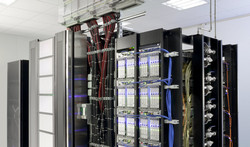Supercomputers promise to tackle pressing global issues
Exascale computing, in which a quintillion (1018) calculations can be performed every second, is expected to become the standard for supercomputers over the next few years. The impressive success of applying in silico (performed on computer) simulation techniques to highly complex scientific and commercial problems has increased the demand for large, fast and powerful systems that can handle the intensive workload involved. The DEEP(opens in new window) and DEEP-ER projects (Dynamical Exascale Entry Platform / -Extended Reach), involving 20 partners across ten European countries, built computer prototypes to implement the innovative Cluster-Booster concept. Complex parts of a programme with limited parallelism execute on the Cluster, while the Booster runs highly parallelisable parts with high energy efficiency. Turbocharged computing ‘The DEEP prototypes are very flexible systems that have a lot in common with a turbocharged engine,’ explains project manager Estela Suárez. ‘They are engineered for performance and energy efficiency, while at the same time ensuring ease of use. The latter is achieved by providing a full system software stack and a standards-compliant programming environment to our users.’ Some 11 scientific and engineering applications, representative of future Exascale computing requirements, were carefully selected to drive hardware/software co-design. These included brain simulation, climate research, radio astronomy, seismic imaging for the oil and gas industry and human exposure to electromagnetic fields. Typical future users might also include neuroscientists, astronomers, meteorologists, seismologists, physicists, aeroplane designers, automotive engineers and many others, since the concept is designed to cover the needs of very different kinds of applications. Whereas in the first project (DEEP), the focus lay on bringing to life a prototype as proof of concept for the Cluster-Booster approach, the ambitious R&D developments of DEEP-ER concentrated on improving the software stack and leveraging innovative memory technologies. DEEP-ER delivered on substantial additional parallel Input/Output (I/O) capability for higher throughput. Plus, it made the supercomputer more resilient through a multi-level checkpoint and restart mechanism that guards against data loss should any hardware fail. Key to these achievements was a strong co-design approach. System software experts worked closely with the hardware team to leverage the innovative, multi-level memory system for I/O and resiliency. On top of this the system software team acted as a link to end users, to ensure that they are able to make efficient use of the new innovative technologies. The radio astronomy application by partner ASTRON for example was able to achieve considerable performance improvements with respect to I/O using one of the innovative memory technologies implemented in DEEP-ER. The results achieved in DEEP-ER cut across the complete HPC stack and demonstrate strikingly the innovative potential of European universities, research centres, as well as European industry and SMEs. Deeper into supercomputing Ahead in the DEEP projects roadmap is the realisation of a Modular Supercomputer in the DEEP-EST (“DEEP - Extreme Scale Technologies”) project, which started in July 2017 and runs until mid-2020. DEEP-EST will generalise the Cluster-Booster approach to create a unique HPC system that couples several compute modules in one machine. Each module is a multi-node system tailored to the needs of a specific group of applications – be they traditional HPC applications, HPDA (high performance data analysis) codes or data intensive applications. Users will be able to mix and match the resources provided by the modules and thus configure their very own supercomputer according to the building-block principle. The EU has contributed with a combined total of almost EUR 30 million to DEEP, DEEP-ER and DEEP-EST projects.



